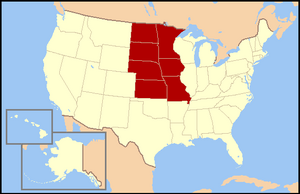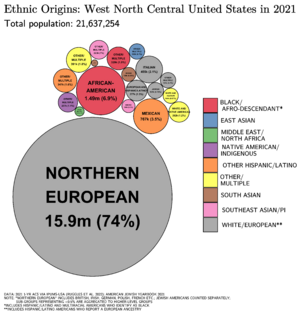West North Central states facts for kids
Quick facts for kids
West North Central
|
|
|---|---|
|
|
|
 |
|
| Composition | |
| Metropolitan areas |
|
| Largest city | Minneapolis-St. Paul, MN |
| Area | |
| • Total | 507,913 sq mi (1,315,490 km2) |
| Population
(2020)
|
|
| • Total | 21,616,921 |
| • Density | 42.56028/sq mi (16.432617/km2) |
The West North Central states form one of the nine geographic subdivisions within the United States that are officially recognized by the U.S. Census Bureau.
Seven states compose the division: Iowa, Kansas, Minnesota, Missouri, Nebraska, North Dakota and South Dakota and it makes up the western half of the United States Census Bureau's larger region of the Midwest, the eastern half of which consists of the East North Central states of Illinois, Indiana, Michigan, Ohio and Wisconsin. The Mississippi River marks the bulk of the boundary between these two divisions.
The West North Central states are regarded as constituting the core of the nation's "Farm Belt." Another name popularly applied to the division is the "Agricultural Heartland," or simply the "Heartland."
Since the early 1990s, the West North Central division has consistently had the lowest unemployment rate in the United States (especially in its many college towns), and has also been noted for its plentiful supply of affordable housing.
Demographics
As of 2020, the West North Central states had a combined population of 21,616,921. This number is a 5.4% increase from 20,505,437 in 2010. The West North Central region covers 507,913 square miles (1,315,489 km2) of land, and has an average population density of 42.56 people per square mile.
| State | 2020 census | Land area |
|---|---|---|
| Iowa | 3,190,369 | 56,272 |
| Kansas | 2,937,880 | 82,277 |
| Minnesota | 5,706,494 | 86,939 |
| Missouri | 6,154,913 | 69,709 |
| Nebraska | 1,961,504 | 77,354 |
| North Dakota | 779,094 | 70,700 |
| South Dakota | 886,667 | 77,116 |
| City | 2020 pop. | |
|---|---|---|
| 1 | Kansas City, Missouri | 508,090 |
| 2 | Omaha, Nebraska | 484,983 |
| 3 | Minneapolis, Minnesota | 434,341 |
| 4 | Wichita, Kansas | 390,780 |
| 5 | St. Louis, Missouri | 318,416 |
| 6 | St. Paul, Minnesota | 310,468 |
| 7 | St. Louis, Missouri | 292,601 |
| 8 | Lincoln, Nebraska | 292,201 |
| 9 | Des Moines, Iowa | 215,293 |
| 10 | Overland Park, Kansas | 197,783 |
| 1 | Twin Cities (MN-WI) | 3,685,561 |
| 2 | St. Louis, MO-IL | 2,806,100 |
| 3 | Kansas City, Missouri-KS | 2,172,902 |
| 4 | Omaha, Nebraska-IA | 963,221 |
| 5 | Des Moines, Iowa | 721,326 |
| 6 | Wichita, Kansas | 649,230 |
| 7 | Springfield, Missouri | 473,702 |
| 8 | Quad Cities IA-IL (Davenport) | 376,502 |
| 9 | Lincoln, Nebraska | 340,954 |
| 10 | Duluth, MN-WI | 287,430 |
Politics
| Parties | |||||
| Democratic-Republican | Democratic | Republican | Liberal Republican | Populist | Progressive |
- Bold denotes election winner.
See also
 In Spanish: Centro Noroeste de Estados Unidos para niños
In Spanish: Centro Noroeste de Estados Unidos para niños






